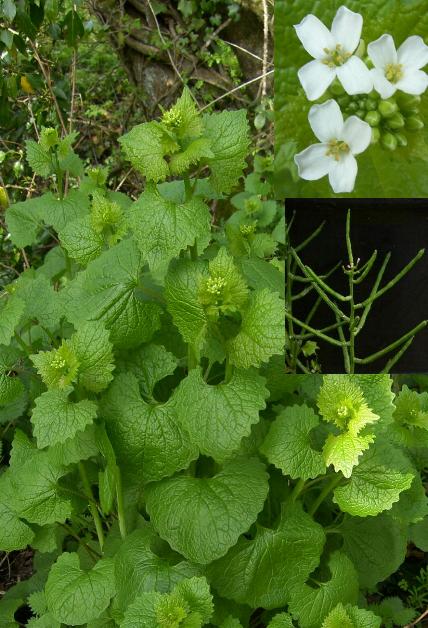Garlic MustardScientific Name: Alliaria petiolata |
Garlic Mustard is a biennial found in hedgerows and damp, shaded areas at the edge of woods. A native to Europe, parts of Asia and North Africa, it was introduced to North America in the mid nineteenth century as a culinary herb, but is now considered a noxious weed in some states due to the density of its crop of seedlings which can become the dominant species in the understorey vetegation to the detriment of native plants. The roots release an alleopathic chemical which has an inhibiting effect on beneficial mycorrhizal fungi of nearby plants and this allows it to thrive in places where it is not part of the native flora. In its own native regions this does not seem to occur, so this increases the invasive nature of Garlic Mustard.
It is a food plant for the Green-veined white butterfly and the seeds provide food for birds.
In folk medicine Garlic Mustard has been substituted for the real thing where Wild Garlic is not so prevalent. Uses have included chewing leaves to treat sore gums and mouth ulcers, applying externally to sore throats or rubbing on the feet to cure cramp.
The leaves are heart-shaped with a toothed margin and long stalks. They have a flavour of a mixture of garlic and mustard and can be eaten in salads or made into a pesto. The white, horse-radish scented taproot develops in the first year with the basal rosette of leaves which remain through winter and in the second year the upward stem can reach 30 to 100 cm depending on conditions.
In the spring and summer of the second year the edible, white, four-petalled flowers are produced in clusters which open in succession. They are self-pollinated or by a variety of insects and the thin, four-sided pod which holds the shiny, black seeds splits open for dispersal when it matures to a grey-brown colour. Each plant can produce hundreds of seeds which are shed from July onwards, land within several metres of the parent and can remain viable for up to five years. The dormancy is broken by chilling and germination starts between January and April.
This is not usually a problem weed in the British Isles and would make a good addition to a woodland setting providing some leaves to pep up a salad. It is easily uprooted, but can regrow from adventitious buds on the taproot if it is not completely removed. Repeated close cutting will prevent the flowering shoot from developing and the seed
Weedkillers to use:-A residual herbicide should prevent germination on paths.
Paraquat, Diquat contact action gives an immediate knock-down, so it should not have time to set seed, if caught in time.
Follow these links for further details on Weeds, Weed Removal and Weed Prevention.
